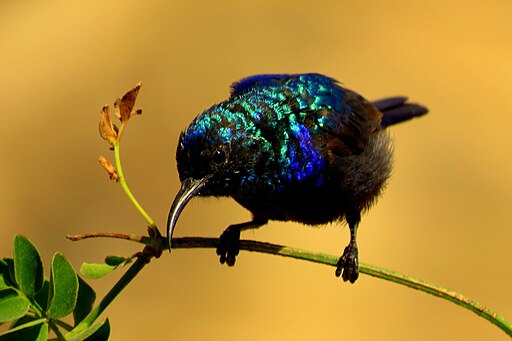

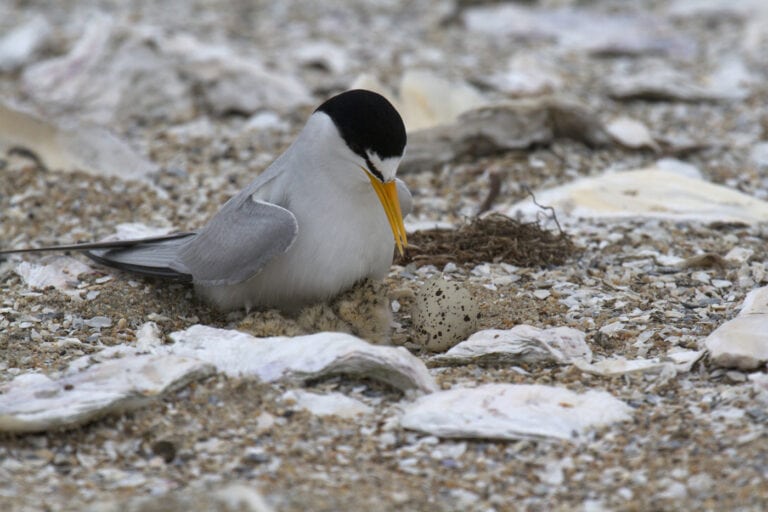
De-Pave Park in Alameda: A Win for the Birds
By Sharol Nelson-Embry and Linda Carloni
Last night was a win for the birds as the Alameda City Council voted four-to-one in favor of offering the maximum amount of wildlife habitat at “a “De-Pave Park”, a planned nature park on a section of the former Naval Air Station, now called Alameda Point. At least seven speakers talked passionately and eloquently about how the removal of the existing structures was important in creating the largest habitat possible for birds and other wildlife, as well as a shoreline that will accommodate sea-level rise, sequester carbon, and provide a place for people to enjoy nature and the expansive views of San Francisco.
.kb-image58043_d05028-42 .kb-image-has-overlay:after{opacity:0.3;}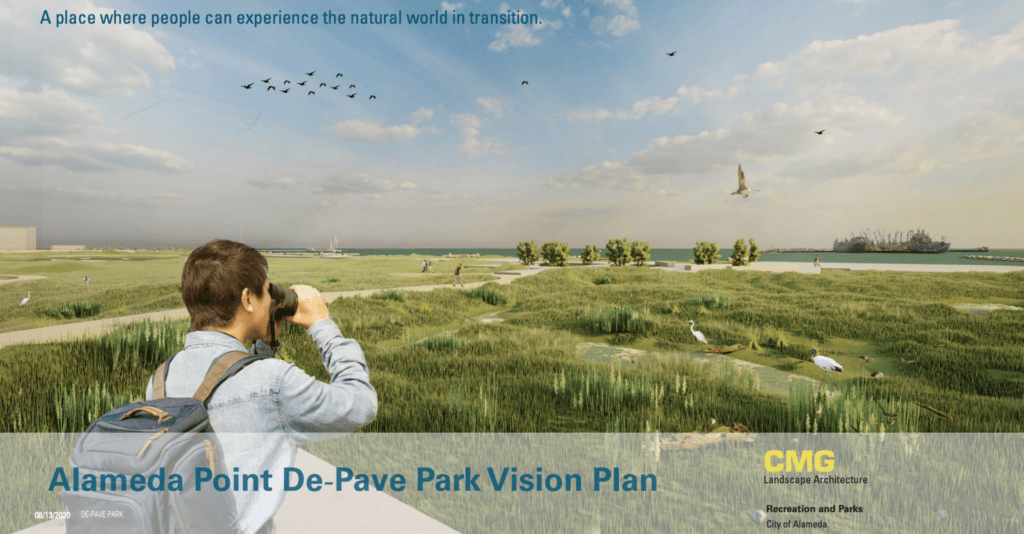 Final De-Pave Park Vision Plan
Final De-Pave Park Vision Plan
De-Pave Park has been in the works since 2014, when it was first proposed to remove the paving on a section of the old Naval Air Station (thus the name, “De-Pave”) and create a nature-oriented park with public access and intertidal connection. The process included extensive public outreach to people and businesses from throughout Alameda including; Friends of the Alameda Wildlife Reserve (FAWR) – the GGBA Conservation Committee for the City of Alameda – as well as our allies from the Sierra Club, Baykeeper, and Community Action for a Sustainable Alameda (CASA). During the process, the City, partnering with Literacy for Environmental Justice, received an $800,000 grant from the San Francisco Bay Restoration Authority (Measure AA funding). The grant funds a community stewardship program, completion of a master plan and 30% of the design plans.
The most recent planning phase gathered public input on the options of retaining one of the structures and its support buildings, referred to as Building 25, with a large section of land around it protected by a levee (Option 1); or retaining Building 25 with a reduced section of land still protected by a levee (Option 2); or demolishing Building 25 and using the additional three acres to create a larger nature park (Option 3). FAWR, alongside its allies, has worked hard to support Option 3 with letters written by GGBA Executive Director, Glenn Phillips, our allies and our FAWR members. We’ve gone to multiple meetings and spoken to support the full nature park afforded by Option 3, and written articles for the local newspapers and online news outlet, the Alameda Post to educate Alameda residents about the importance of creating new wetlands for the birds.
.kb-image58043_fc1363-7b.kb-image-is-ratio-size, .kb-image58043_fc1363-7b .kb-image-is-ratio-size{max-width:664px;width:100%;}.wp-block-kadence-column .kt-inside-inner-col…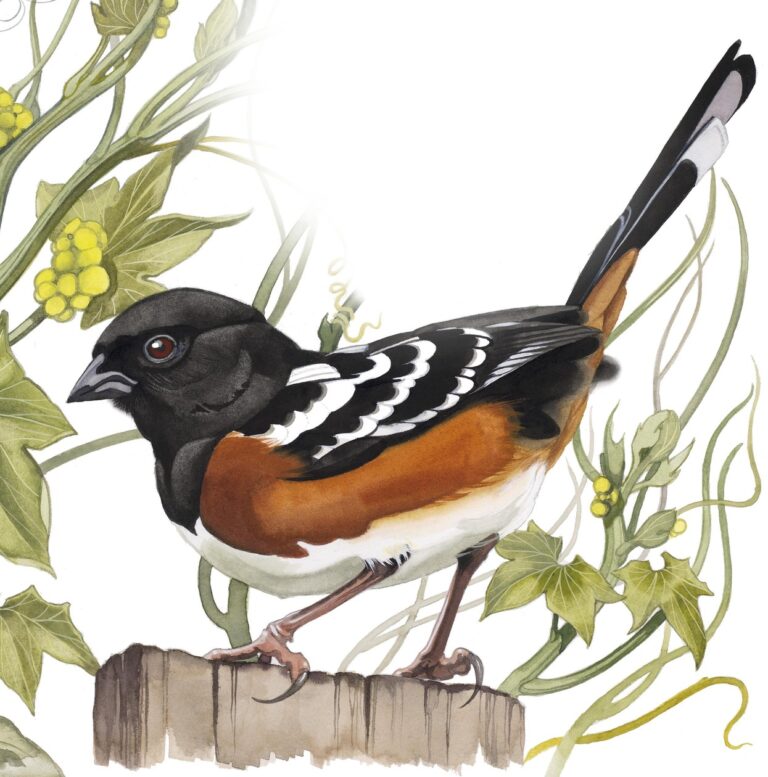
Sequela: Nature Poems in Response to Climate Crisis
by David Rice
Art by Tex Buss
Tanka is a lyrical poetic form written in Japan for the past twelve-hundred-plus years and by English-language poets for about a hundred years. It aims to crystallize emotional responses to specific perceptions and often includes a link-and-shift somewhere in its five lines.
dawn
three coyotes watch me
and a thrush sings
could be the last century
— we can’t go back
Adding prose allows the poet to expand the context of the short poem. I have written a tanka prose book, “Sequelae”, that looks at our responses to the climate crisis. Tex Buss’s painting is on the cover, and the book also includes nine of her bird paintings.
.kb-image58041_5fdad2-f0 .kb-image-has-overlay:after{opacity:0.3;}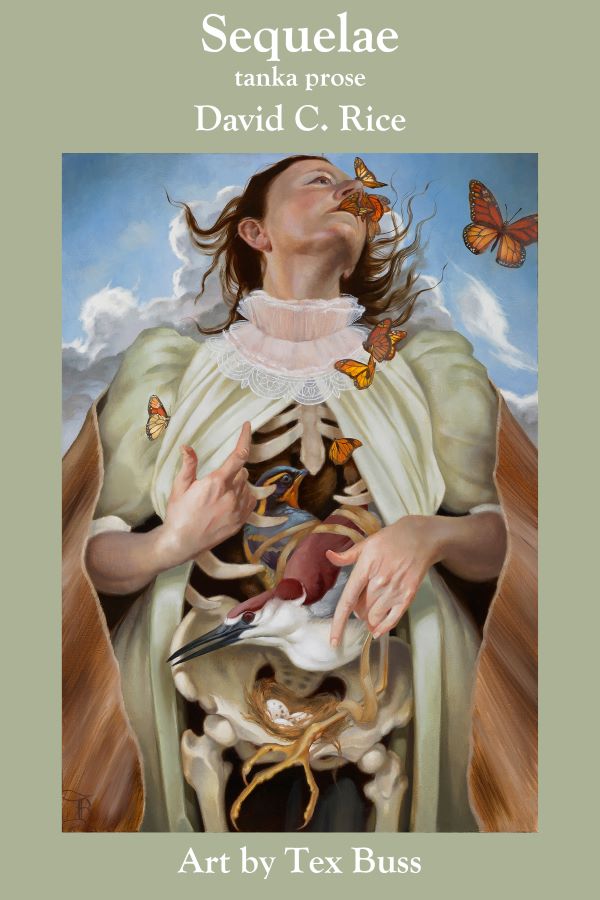
Room For Improvement
If we were to change our climate course, who would steer? The wealthiest five-percent, who use thirty-five percent of the carbon, are on cruise control. Those who lack resources are just trying to stay on the road. Can those of us in the middle grab the wheel and turn us off the super-sized highway?
a woodpecker hammers but
that telephone pole
is no longer a tree
how do we drill
beneath our daily routines?
Lost Bird: Reward
Mid-1950s, snow on the ground, and one morning a flock of Evening Grosbeaks in our backyard. The bird book promised warblers in spring. Back then, climate change was for geologists, extinction for dinosaurs.
the global thermometercardinal red
we’re goldfinch
so pleased with our song
we can’t stop
Money, fittest of all survivors, always flies. The oil barons could leave some in the ground, but depending on alpha predators to nurture their prey for the common good is a bad bet. Still, I’ve got to put my chips down . . . on green.
old jigsaw puzzle
a robin hidden
in a leafed-out oak
I must keep looking
for the lost piece
The book also contains four prose birding pieces.
I can close my eyes and see the Short-eared Owl perched on the standing four-foot, broken-off tree trunk in the middle of the meadow as twilight fades to night. Then it’s another year, and I see the full-moon-lit meadow, where magic is afoot and anything is possible.I’ve spent six months here, over a forty-year period, backpack camping at Snag Lake. These trips were Golden Gate Audubon Society birding trips I co-led with Robin Pulich. The tiny lodgepole pines have advanced on the meadow from the forest, and then have died when a heavy snow-melt year submerged the meadow in two feet of water.…
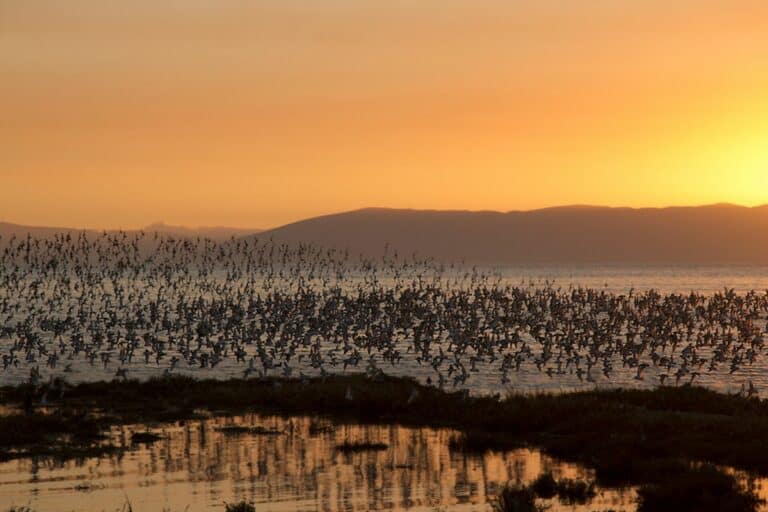
A Day in the Life of a Climate-Friendly Birder
By Joyce Mercado
We all love observing and identifying birds. What joy birds bring us! We naturally want to protect what we love. With that said, climate change is a big threat to birds. When we use fossil fuels like coal, oil, and natural gas for energy, we release carbon dioxide into the atmosphere. This excess carbon dioxide acts like a heat-trapping blanket, warming our air, land, and sea. A change in our climate results in a movement of food supplies for birds, a disruption of established migratory patterns, and a loss of critical habitats that serve as breeding and feeding grounds. Audubon’s research shows that two-thirds (389 out of 604) of North American bird species are at risk of extinction from climate change.
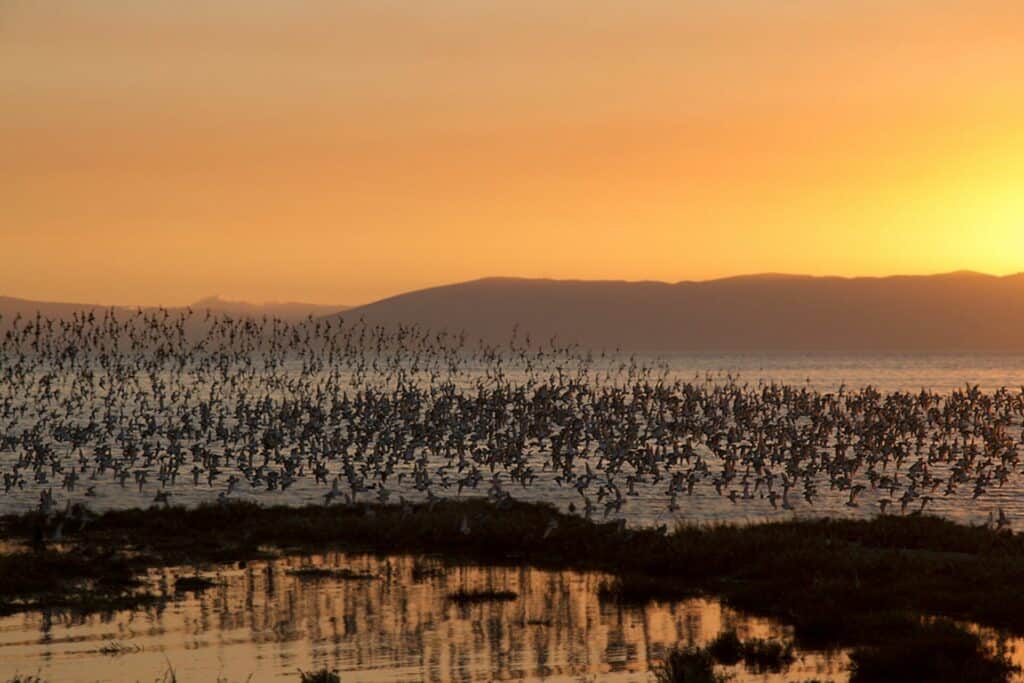 Shorebirds at Elsie Roemer – Rick Lewis
Shorebirds at Elsie Roemer – Rick Lewis
The good news is that science also shows that if we act now, we can help improve the chances for 76% of species at risk. What can one birder do to help protect the climate and thereby help protect our feathery friends? Climate change can seem to be an overwhelming challenge, but there is a lot birders can do individually to protect the climate.
Let us look at a day in a birder’s life. You are planning a trip with a friend to go birding. After your cup of bird-friendly coffee (check out Golden Gate Bird Alliance’s bird-friendly coffee club for an easy way to buy shade-grown organic beans), the first thing to sort out is transportation. Perhaps you can bike or walk to a favorite birding spot for a zero-emissions trip, if it is close enough. If that is not feasible, carpooling with your friend cuts trip emissions in half. Even better if one of you has an electric vehicle. You have recently checked your tire pressure to improve mileage by as much as three percent. And you are not hauling around a bunch of stuff in your vehicle that you do not need on a regular basis, since that hurts gas mileage.
 Reusable Sandwich Bags
Reusable Sandwich Bags
Pack your lunch and snacks in a reusable lunch bag with reusable silicone baggies or beeswax wrap. The less single-use stuff we use the better, because all consumer goods generate emissions in their manufacture, shipping, and disposal. The most climate-friendly lunch will be mainly plant-based, since fruits, vegetables, grains, nuts, legumes, bivalves, and small ocean fish produce less emissions than meat, dairy, or other seafood products.…
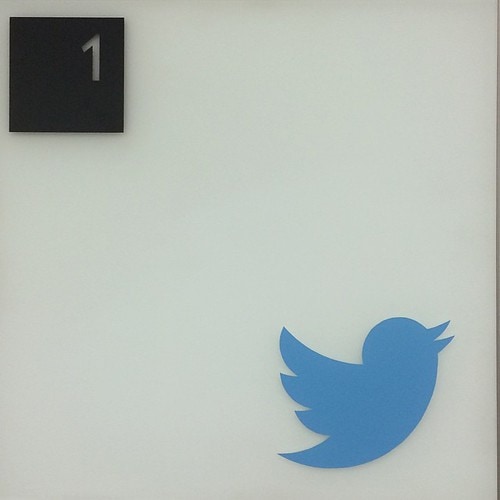
Lights out for Larry: The Burden of Brightness on Birds
Two weeks ago, a common blue bird disappeared from the city of San Francisco.
You know the bird.
 Credit: Rulenumberone CC License
Credit: Rulenumberone CC License
The one soaring with its upturned belly, migrating through the digital space. I guess its name was Larry.
Back in 2012, when Martin Grasser, Todd Waterbury and Angy Che began designing the twitter logo, Larry, they wanted the bird to feel less like an individual artist’s interpretation, and more like a system of “overlapping circles and connections”.
This blog is about the overlapping circles, where social media meets ego, where visibility and convenience meets moderation and safety, where artificial light meets the dark star-studded sky and migrating birds meet our urban cities. This blog piece is about Larry, the thing that replaced Larry, and a reminder for all of us to encourage building owners and managers to turn off their lights at night.
You see, on Monday, July 24, twitter owner Elon Musk announced a new rebrand for the social media platform. That very same Monday (at least based on SF Department of Building Inspection complaint reports), workers began tearing down Larry from the side of the building headquarters of what is now known as X, without the proper permits from the city of San Francisco.
Apparently, the workers were asked to stop Larry’s removal because; 1. They didn’t have the proper permits to start the process to begin with and… 2. They hadn’t closed off the sidewalk where the unofficial worksite was, thereby putting people in danger… yikes.
Let’s just say, before you go removing birds from their nests, always check with a professional before proceeding with business as usual. (Need a nest survey? Contact your local wildlife biologist here). But I digress.
Credit: Fact Intensity
By Friday, July 28, complaints started flooding the SF Department of Building Inspection tracking system, with residents of San Francisco pointing out a giant flashing sign in the shape of an X at the top of X’s headquarters secured to a temporary ballast, or as one complaint noted “a couple of sandbags”.
But, what does this have to do with real birds? Don’t worry I’m getting there…
Twenty four complaints were filed in all. With most noting how structurally unsound the sign seemed, how the light was too bright at night, how people living in the general vicinity couldn’t sleep, how the flashing strobe-like effect could cause epileptic seizures, that it could potentially distract drivers and cyclists and that it was generally disorienting and nausea inducing.…
